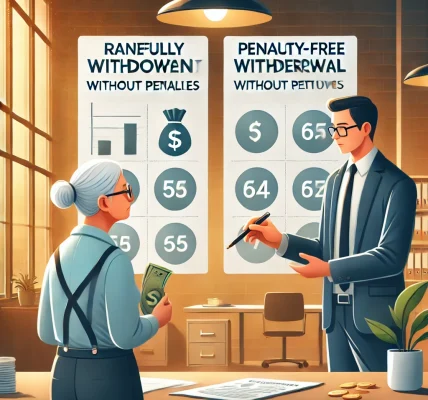Saving for retirement can be a daunting task. With so many variables to consider—such as your lifestyle goals, future expenses, and inflation—it’s hard to know exactly how much you should be putting away. The truth is, there’s no one-size-fits-all answer. However, by understanding a few key principles and breaking down the process into manageable steps, you can confidently plan for a secure retirement.
In this comprehensive guide, we’ll help you determine how much you should save for retirement based on your unique circumstances, and we’ll provide strategies to ensure you reach your retirement goals.
Why You Need to Plan for Retirement
The primary reason to save for retirement is to ensure that you don’t outlive your savings. The earlier you start saving, the more time your money has to grow. The goal is to have enough saved to replace the income you’ll no longer receive from work, allowing you to maintain your standard of living.
How Much Should You Save Each Year?
The amount you need to save for retirement depends on a variety of factors, including your desired lifestyle, age, and how long you expect to live in retirement. However, financial experts generally recommend saving at least 15% of your gross income for retirement each year. This figure can vary based on your circumstances.
Step 1: Set a Retirement Savings Goal
Before determining how much to save, it’s important to know how much you will need in retirement. You can start by estimating your retirement expenses, which can include:
- Housing costs
- Healthcare
- Food and transportation
- Leisure activities, hobbies, and travel
- Taxes and insurance
- Miscellaneous living expenses
Rule of Thumb: A common rule of thumb is that you’ll need about 80% of your pre-retirement income to maintain your current lifestyle during retirement. For example, if you’re currently earning $100,000 per year, you should aim for $80,000 annually in retirement.
Step 2: Consider Your Retirement Age
The age at which you plan to retire will impact how much you need to save. If you plan to retire early, say at 55, you’ll need a larger nest egg to cover a longer retirement. If you plan to retire at 67, the amount you need to save will likely be less because you will have fewer years to cover.
For example, if you retire at age 67, the average life expectancy for a woman is around 85 and for a man, around 82. That’s 15-18 years in retirement where your savings need to last. If you plan to retire at 55, your savings would need to cover 30 years or more, which is why early retirees need to save aggressively.
Step 3: Factor in Inflation
Inflation erodes the purchasing power of your money over time, so it’s essential to account for it in your retirement planning. Historically, inflation has averaged around 3% per year. This means that in 30 years, the cost of goods and services will likely be 2.4 times higher than today’s prices.
Tip: When calculating how much you need to save, always factor in inflation. If you’re planning for a retirement goal 30 years in the future, aim to have a larger target amount to account for inflation’s effect on living expenses.
Step 4: Calculate Your Retirement Savings Using a Retirement Calculator
Once you’ve set a target retirement income, you can use a retirement savings calculator to estimate how much you need to save each month. Many calculators ask for your current savings, the age at which you plan to retire, expected rate of return, and the amount you plan to spend during retirement.
For example:
- If your goal is to replace 80% of your income in retirement, and you expect to live on $80,000 per year, you’ll need to save enough to generate $80,000 annually from your investments.
- If you plan to withdraw 4% of your savings annually, you’ll need about $2 million in your retirement account by the time you retire to achieve that $80,000 yearly income.
Step 5: Save and Invest for Growth
To meet your retirement goals, you need to consistently save and invest. It’s important to start early so your investments have time to grow. The power of compound interest means that the earlier you start saving, the more your money can grow over time.
- Invest in Stocks and Bonds: A diversified investment strategy that includes stocks and bonds will help your money grow at a faster rate than traditional savings accounts. Generally, stocks offer higher returns, but they also come with higher risk.
- Maximize Employer-Sponsored Plans: If your employer offers a 401(k) or 403(b) with a match, take full advantage of it. This is essentially free money, and you should try to contribute enough to receive the maximum match.
- Contribute to IRAs: In addition to employer-sponsored plans, consider opening an IRA (Traditional or Roth) to save even more for retirement.
Step 6: Adjust Your Savings as You Age
As you get older, your ability to save more may change. If you started saving late or want to boost your savings for a comfortable retirement, you can:
- Increase your savings rate: If possible, try to save more than 15% of your income as you near retirement age.
- Delay retirement: Working a few extra years can provide more time to save and allow your investments to grow.
- Catch-up Contributions: Once you turn 50, you’re allowed to make catch-up contributions to your 401(k) and IRA. For 2025, you can contribute an additional $7,500 to your 401(k) and an extra $1,000 to your IRA.
How to Stay on Track with Your Retirement Savings
- Review your plan regularly: Track your progress and make adjustments as necessary. Life changes, so it’s important to revisit your plan periodically.
- Monitor your spending: Keep an eye on your spending habits and avoid lifestyle inflation, which can prevent you from saving more.
- Maximize tax-advantaged accounts: Take full advantage of 401(k)s, IRAs, and other tax-advantaged accounts to boost your savings and minimize taxes.
Conclusion
Determining how much to save for retirement is a critical aspect of financial planning. While the amount you need depends on various factors such as your desired lifestyle, retirement age, and expected expenses, a good rule of thumb is to save 15% of your income for retirement. Start early, invest wisely, and regularly reassess your plan to stay on track. Remember, the key is consistency and making your retirement savings a priority now so that you can enjoy a comfortable and stress-free retirement later.




